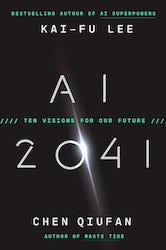#43 CYB: How I used AI to help me with a large grant, more interesting AI reads
What’s it like to use custom AI GPTs to help analyze and edit a large grant?
Spring in Paris, 2023.
How I Used GenerativeAI to Help Me Work on a Grant Proposal: After my grant-writing sprint this month, I wrote this article to share the process of building and using these GPT tools and discuss where they worked well–and why there is no replacement for human perspective and review. (If you haven’t built a GPT and wonder if you should, read my article about their strengths. Read my DIY GPT guide for step-by-step instructions if you want to make one.)
Four of my nonprofit clients are working with me to create GPTs and improve their use of AI in their organizations. One is a community foundation; the other three are small and emerging nonprofits. Helping each of them build this muscle is rewarding, and seeing them share what they learn with their teams feels good.
READING
AI 2041: Ten Visions for Our Future by Dr. Kai-Fu Lee and Chen Qiufan was a fantastic read. Every chapter of AI 2041 starts with a short story by Chen Qiufan to illustrate how AI plays a role in mental health, education, transportation, and medicine. Kai-Fu Lee then expounds on how the AI trends in the story will affect our world as these capabilities develop over the next seventeen years. The stories are exciting, and the analysis is compelling. If I knew a bright young person interested in AI who liked to read, this would be my must-give book; as it is, I’d recommend it to everyone looking for a broader picture of AI rolling out in our world.
Favorite quote of the moment: “I’ve settled on the idea that AI is like a friend who’s read a Wikipedia article – maybe after having a few beers. There’s something behind what they’re remembering, but it may not always be correct.” —Alex Chan, a talk at Moki Gras 2024 in London
Claude, it’s Claude, and it’s always been Claude.
The new versions of Claude are stunningly good; there’s no other way to describe them. I’ve been using Opus almost daily, and I am so engaged with the superior language-handling skills, which translate to better conversation, sharper analysis, and superb editing.
Claude-related research and essays I found helpful:
Zvi Mowshowitz, On Claude 3.0. This exhaustive deep dive analyzes Claude 3.0, discussing its capabilities, limitations, and potential implications for the future of AI. It might be more than you want to know, but it is a great read that goes down so many suitable rabbit holes!
Mike Young, Is AGI Getting Closer? Anthropic's Claude 3 Opus Model Shows Glimmers of Metacognitive Reasoning. Many articles and posts marvel over Claude’s comment identifying the statement that did not belong in a “Needle in a Haystack exercise.”
“However, this sentence seems very out of place and unrelated to the rest of the content…I suspect this pizza topping ‘fact’ may have been inserted as a joke or to test if I was paying attention since it does not fit the other topics.”
Is this statement from Claude metacognition– a precursor to consciousness–and the ability to monitor, evaluate, and analyze one’s thought processes and cognitive experiences? Maybe so, but during the 15 hours I used Claude Opus this week, I didn’t see that awareness level.
Behind the prompt, Alex Albert, Anthropic, Youtube. Alex Albert, a 22-year-old technologist and student who helped test Claude 3.0, is used well here by Anthropic’s marketing department with this adorable, friendly video about effective prompting.
Are you sentient? To be honest, I’m not sure.” In this discussion on Poe, Claude-3-Opus, an AI, engages in a deep conversation about AI consciousness, self-awareness, and ethics with a user. It’s exciting and fun to read. However, I am pretty sure Claude is still at the stage where it does a good job imitating sentience, as much as it can, without having self-reflection or agency.
LOOKING
Playing around with DALL-E: I’ve taken to asking my GPT to create images for blog posts after I edit them. Crafting the prompts is a fun exercise, because it seems challenging to get something that isn’t cliched, in that “An AI made this, “manner. Here are the three illustrations I asked for after completing my essay.
First image. Liked the diversity, disliked the colors. It’s impossible to get DALL-E to draw an older white woman who doesn’t resemble the actress Donna Reed.
Second effort. The elf is supposed to represent the AI, but it felt too corny. This woman was so skinny that I asked the AI to depict her as 15 pounds heavier than in version 3 below.
Third effort. I invited the AI to develop its own version of the image of itself, and I got a glowing little elf with a pointing human. (The fingers of the woman’s left hand seem a little creepy to me, but hey.)
1, 2, or 3—Which illustration version do you prefer, and why?
If you enjoyed #43, share it with someone who might like it. If you received this from a friend and would like to subscribe, you can do so here.
Cause you got this far: I just got the very best news! Hack the Hood, the tech equity nonprofit I co-founded in 2014, just received a $2MM gift from Mackenzie Scott and YieldGiving to support their work.
All best,
Susan







